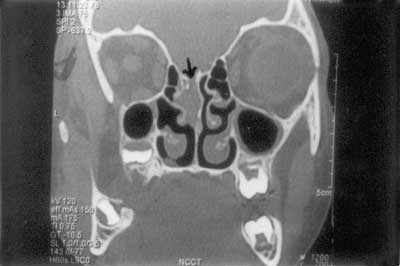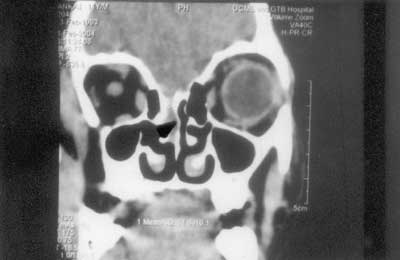From the Departments of Radiology & Imaging and
Pediatrics*, University College of Medical Sciences & GTB Hospital,
Dilshad Garden, New Delhi 110 092, India.
Correspondence to: Professor Satish K. Bhargava,
Department of Radiology and Imaging, University College of Medical
Sciences & GTB Hospital, Dilshad Garden, New Delhi 110 092, India.
Manuscript received: July 22, 2004; Initial review
completed: December 3, 2004; Revision accepted: April 21, 2005.
Abstract:
We report two children presenting with inter-mittent CSF rhinorrhea
and recurrent meningitis. CT scan showed transethmoidal
meningoencephalocele.
Key words: CSF rhinorrhea, Encephaloceles.
Cerebrospinal fluid (CSF) Rhinorrhea is commonly
caused by trauma involving the floor of the anterior cranial fossa
with tearing of the duramater. Rarely, congenital defects in the skull
base associated with cephaloceles(1) can result in CSF rhinorrhea. We
report two children with CSF rhinorrhea and recurrent meningitis in
whom the diagnosis of transethmoidal meningoencephalocele was made by
multislice CT without the use of any contrast.
Case Report
Case 1
An 11-year-old boy presented with complaints of
nasal discharge off and on since last 1 year. The discharge increased
on bending the head down, coughing and sneezing. During this period
there were three episodes of high-grade fever, requiring
hospitalization. There was a past history of fall from height at the
age of 1 year with bleeding from the nose. The intervening period of
8-year following trauma were uneventful.
With a provisional diagnosis of CSF rhinorrhea with
recurrent meningitis, a non-contrast multislice spiral CT scan of the
paranasal sinuses was performed. The CT scan showed a defect in the
cribriform plate of the ethmoid bone on the left side (Fig. 1a).
A mass showing mixed soft tissue and fluid attenuation was seen
herniating through the defect into the left ethmoid sinuses and nasal
cavity. (Fig. 1b). The frontal lobe was also seen herniating
downwards through the defect. Multiplanar reconstruction allowed us to
delineate the bony defect and soft tissue mass better. (Fig. 2).
MRI with MR Cisternography confirmed the diagnosis of transethmoidal
meningoencephalocele.
 |
 |
Fig. 1a.
Coronal bone window and soft tissue window CT images. Defect in
the cribiform plate of ethmoid bone on the left side (arrow).
|
Fig. 1b. Mixed
soft tissue and fluid attenuation mass herniating through the
defect into the left ethmoid sinus and into the left nasal
cavity. Frontal lobe also seen herniating downwards. |
 |
|
Fig. 2. Large defect in the right cribriform
plate with a mass showing fluid and soft tissue
attenuation(arrows ) herniating through it into the posterior
ethmoid sinuses along with the right frontal lobe. |
The child underwent endonasal endo-scopic
ethmoidectomy. The left middle turbinate was resected. Brain tissue
was found protruding from the cranial cavity between the middle and
superior turbinate laterally and perpendicular plate of ethmoid bone
medially. Anterior ethmoidectomy was done. A defect was found in the
olfactory fossa. The protruding brain tissue was cauterized and
removed. The defect was repaired with a graft harvested from the right
conchal perichondrium along with surgical gel. Post- operatively the
child was put on anti-convulsants prophylactically. Lumbar puncture
catheter was inserted in subarachnoid space to decrease CSF pressure
and removed after 4-5 days. The child was asymptomatic on follow up
after 2 months.
Case 2
A 12-year-old boy presented with recurrent pyogenic
meningitis and rhinorrhea comprising clear watery fluid from the right
nostril off and on since the last 3 years. There was no past history
of trauma. A multislice spiral non-contrast CT scan showed a large
defect measuring 1.4 × 0.7 cm in the right cribriform plate. A mass
with fluid density was seen herniating through the defect into the
posterior ethmoid sinus along with the right frontal lobe. A diagnosis
of congenital transethmoidal meningoencephalocele was made which was
later confirmed on MRI. The child underwent a right frontal
craniotomy, which showed a defect at the base of the frontal lobe with
brain matter herniating down. This was excised and the defect closed
with pericranium graft and surgical gel foam.
Discussion
Cephaloceles are congenital herniations of
intracranial contents through a defect in the cranium and duramater.
If the herniation contains only meninges it is a meningocele When the
herniation contains brain along with meninges it is known as
meningo-encephalocele. Transethmoidal encephalo-celes are rare(2)
constituting less than 10% of all encephaloceles(3). It is a rare
cause of CSF rhinorrhea and recurrent meningitis. The transethmoidal
defects lie anteriorly either along the midline or along the
cribriform plate and do not involve the sella turcica. The hernial sac
extends inferiorly into the sinuses or nasal cavity and typically
contains portions of frontal lobes and olfactory apparatus.
Tranethmoidal encephaloceles most commonly present
with recurrent episodes of meningitis(2), intermittent CSF
rhinorrhea(4) or sometimes as a nasal mass. The infant or child can
present with unilateral nasal obstruction, chronic nasal discharge or
headache after forceful blowing of nose(4). They are easily
misdiagnosed as nasal polyps and this can be potentially fatal after
erroneous polypectom(4). Therefore, imaging studies should always be
obtained in patients with polypoidal nasal lesions prior to biopsy.
Associated congenital anomalies like mid face
anomalies, orbital malformations or hydrocephalus may be present.
Besides the typical clinical history the diagnosis of CSF rhinorrhea
was made by invasive investigations e.g., Radioisotope
cisterno-graphy(3). It involved injection of radioactive tracer into
the lumbar CSF, with wool pledgets placed in the roof of both nasal
cavities and subsequently measuring radioactivity in the pledgets to
indicate the anatomic location of leak. A simpler method was to place
Dextrostix in the various sites to look for the glucose in CSF(5). The
presence of a positive 2-transferrrin band in the immunological tests
performed on the nasal fluid proved particularly helpful in diagnosing
CSF rhinorrhea(4).
However, with the advent of multislice spiral CT
and its capability of multiplanar reconstructions a non-contrast CT
scan can non-invasively display the osseous defect beautifully in
cases of CSF rhinorrhea. MRI has a superior soft tissue resolution. It
can define the nature of the cephalocele and allow an accurate
depiction of the olfactory and optic tracts, hypothalamic-pituitary
system associated agenesis of corpus callosum when present(1). MR
cisternography can also be done without intravenous contrast.
In our cases multi-slice CT was able to make the
diagnosis of transethmoidal meningoencephalocele non-invasively in
both the children, without the use of any contrast. Three-dimensional
multiplanar reconstruc-tions with CT allowed a more precise
description of the bony defect than MRI. This is essential for
surgery. However, MRI allows the best description of herniating
meninges, brain or ventricles as well as associated cerebral
anomalies(1) without the use of ionizing radiation. Thus imaging
studies such as CT and MRI should be obtained in patients of recurrent
meningitis with CSF rhinorrhea.
Contributors: PG carried out the radiological
work up, collected the clinical data and reviewed the literature. PG
and VR drafted the manuscript. SKB and VR critically reviewed the
manuscript. AA was responsible for the clinical work up of the cases.
Funding: None.
Competing interests: None stated.
